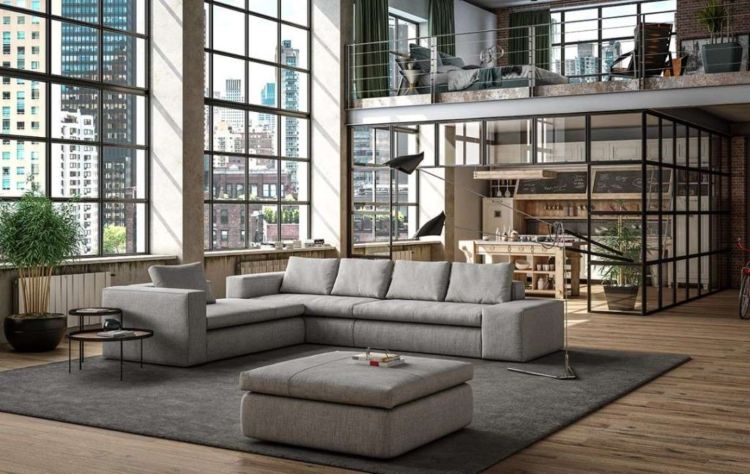Sofa, Sleeper, or Sectional: Which Living Room Seating is Right for You?


Choosing the right seating for your living room is important for both the style and function of your space, so it makes sense to find it a little daunting. Most living rooms are used daily for relaxing, entertaining, and a variety of other activities, so choosing furniture that gives you comfort, style, and functionality is important. We talked with Bonifacio Gonzales, a sales and design associate at Copenhagen, for tips on choosing the ideal seating for your living space. Read on for a breakdown on the unique qualities and benefits of sofas, sleepers, and sectionals to help you find your perfect match.
“The first question to ask yourself is, ‘How many people will be using my living room on a regular basis?’” Gonzales states. “And then, of course I suggest you measure your space in detail. This is the first step to determining the right seating, before considering the style or level of comfort you need.”
Below is a general guideline for measuring and scaling your living room:
We also suggest utilizing our online 3D models and AR feature to get a better feel for the size of your space and any potential furnishings you’re interested in. On over 1,500 product pages, use a phone or tablet and click “View in AR;” you’ll be able to view that item in your real-time surroundings, with accurate measurements and sizing. Once you’ve noted your measurements and played around with our 3D models, you can send the info to your salesperson, and they can draw up your room on Floorplanner – our room designer tool – giving you even more freedom to experiment with different modules.
Gonzales says, “You want to make sure you’re accounting for every fixed variable of your living room, from the doorways to the windows to a TV stand that has a set spot.” Once you’ve compiled your floor plan, finding the perfect seating is that much easier, because you’ll know the space you have available.
Sofas are upholstered seats that typically include three cushions (or two larger cushions), a back rest, and armrests; they usually provide enough seating space, comfort, and support for two to three people. Because sofas have a long-standing history, they come in a variety of sizes and styles, making them the most versatile seating choice for living spaces. “Sofas are a great option for smaller spaces, because many are offered in multiple sizes, such as the loveseat,” says Gonzales, “but longer ones also exist for those who can’t quite fit a sectional in their space.”
The Andria living collection includes both a loveseat-size sofa and traditional sofa; Smaller, compact spaces could benefit from the 64” length of the loveseat or, if the space has a more open floor plan, add an additional loveseat in a corner configuration. A larger space can utilize the larger 80” sofa or pair it with a loveseat for a more entertainment-inclined living room. For a classically sized sofa, March fits the bill, with an 86” length, three seat cushions, and angled arms that offer firm support for three sitters.
Sleepers are a sofa form that unfolds into a bed – serving the dual purpose of providing seating and sleeping space. Because of their ability to seamlessly transition from a comfortable couch to a cozy bed, sleepers allow you to maximize space in smaller living rooms, such as those in apartments or studios. They’re also a great choice if you often entertain guests – a sleeper mitigates the need for an extra guest bedroom but can also serve as additional sleep space for a larger party.
If space is your biggest concern, the Monika sleeper line comes in a multitude of sizes, from a chair sleeper that can accommodate one person to loveseat, queen, and king sizes that can fit more. If you have a bigger living space that can accommodate a sectional but need it guest-ready, then the Halti sleeper sectional is the perfect fit, with a variety of adjustments that will ensure the comfort of everyone. If you’re seeking a more traditional “sofa look,” a thicker design like Haven has a more plush, deep feel, with two included bolster pillows that can be placed anywhere.
Sectionals are the largest seating option, typically made up of several individual units connected together. Though typically considered a less versatile option due to their size, sectionals come in various configurations, from L-shaped and U-shaped structures to rounded and modular designs, making them adaptable to your space. “Sectionals are great for those who enjoy gathering around for family movies or game nights,” Gonzales starts. “With the TV as your focal point, you can easily center your sectional and add in a coffee table for the optimal viewing experience. Alternatively, if you’re someone more interested in entertaining others, you can combine a sectional with a few recliners to create a conversation area.”
Of course, the biggest benefit of sectionals is they offer a variety of ways to relax, creating a living space designed to increase everyone’s comfort. Gonzales says, “Sectionals are available with different features to help customize your comfort. A large design like Bari just on its own has four seats, one corner piece, and a built-in chaise.” This allows multiple people to sit or spread out as they like. Similarly, Gonzales suggests a power motion sectional like Giana; “Three power motion seats all controlled by individual buttons can serve as recliners or even sleeping spots for you and your guests.”
Choosing the right living room seating is easier once you consider your space, needs, and style preferences – whether you’re prioritizing entertainment, comfort, flexibility, or a combination of all three. Luckily, with so many sofa, sleeper, and sectional options and features available, you’re sure to find the perfect seating solution for your living room. For more design and furniture tips, check out our other blog posts or visit in-store to work with one of our sales and design associates.